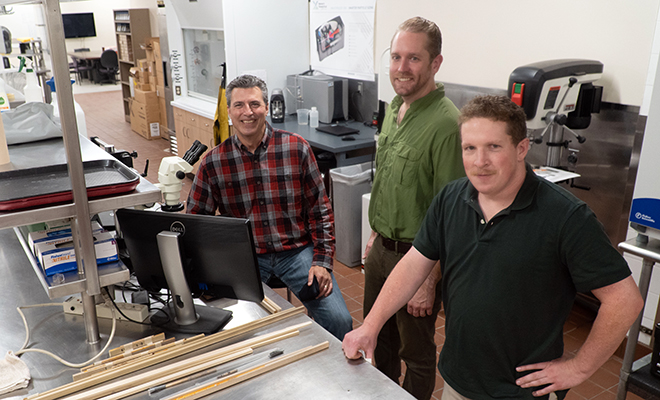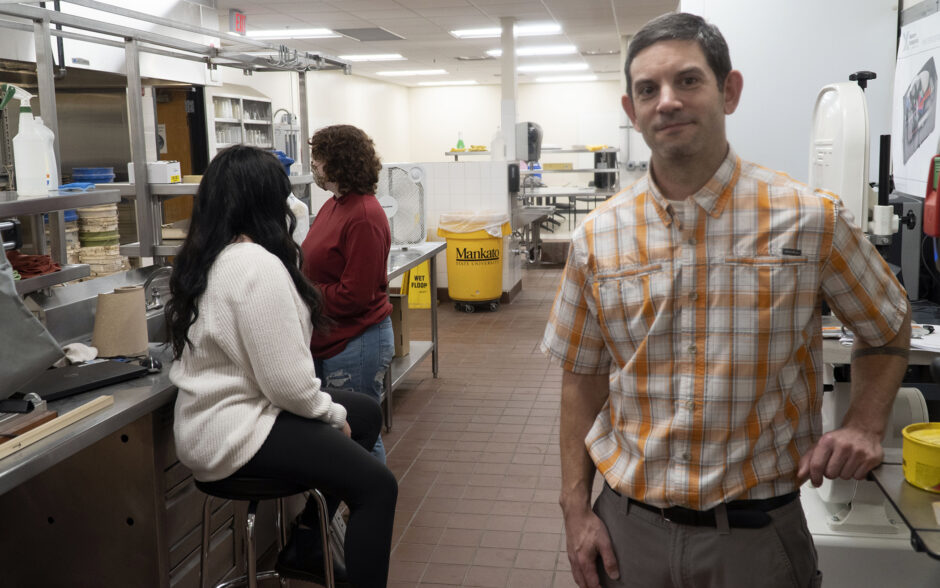The long, cross-sectioned samples of earth brought in and studied by geography students can reveal how that environment changed over thousands of years, before and after human impact.
“So when glaciers were melting and climate was shifting rapidly, what did the soil look like?,” said geography professor Mark Bowen. “And since humans have started manipulating soils and utilizing them primarily for agriculture, what has that impact been and how does that compare to natural events in the past that have been fairly dramatic. Are humans as powerful as these really extreme events or are we just a blip?”

Such questions can be shut down quick if a misplaced backpack is tossed on a soil core sample in a tiny adjunct faculty office—one of several former locations Bowen and others have had to use for labs in earth studies.
Those days are now history thanks to a space in Carkoski Commons that was formerly a kitchen for the residence halls.
That space is now the EARTH Systems Lab, providing a long-needed permanent spot for labs where samples can be studied in an environment of new equipment and space to work.
As teaching goes, the larger space is nothing short of a game-changer. For the bulk of his 17 years teaching at the university, anthropology professor Ron Schirmer has had to host labs in greenhouses, garages and dark basement-level rooms next to abandoned elevator shafts.
“It was really kind of tough to get students interested in archeology as a discipline when they’re like ‘This is where I have to work to do this?’” Schirmer said. “But now, the student enthusiasm for doing this kind of stuff is through the roof again.”
Vacant for several years, the space was eventually obtained after championing by earth sciences director Phil Larson. It was dubbed the EARTH Systems Lab as an interdisciplinary space for faculty in earth science, archeology, and physical geography. It became functional in August of 2020, and after a year the College is ready to show off the space at an open house Nov. 3.

“Anywhere I could find space, I would use it until I couldn’t use it anymore,” Bowen said. “It was a hodgepodge of temporary spaces….“We had an adjunct office, so literally an office where we had file cabinets and desks and I pushed everything up against one wall and just brought in folding tables because these cores are long and you need to lay out cores on a long space.”
Sims, a graduate student en route to a master’s degree in geography, was feeding a small bit of soil particles into a laser diffractometer, a cutting-edge, state-of-the-science piece of equipment that’s accessible to students as a result of the new lab. Her first year of labs as a grad student were done in a tiny basement room in Armstrong Hall.
“I’ve worked in other labs and I’ve seen the before and after of this lab specifically and there’s just a lot of room for different kind of people,” she said, citing Schirmer and Bowen’s work in anthropology and geography, respectively. “It shows the broad spectrum of what you can get done in one single lab. There are so many measurements you can take, so many different tools.”
“Ron, Phil, and Mark have done an outstanding job of developing a collaborative, inter-disciplinary spirit to their work that extends to their students, said Matt Loayza, dean of the College of Social and Behavioral Sciences. “I’m ecstatic that we have a home for the EARTH lab, as it will enable us to provide students with significantly more unique, hands-on opportunities to work with faculty on research, learn important career skills, and contribute solutions to several issues and problems important at both a local and national level.”
Students today are benefitting from the new space and new equipment. Students tomorrow will benefit from grants that can be submitted now that true lab work can be done.
“This opens avenues for us to apply for large grants,” Bowen said. “I’ve submitted grants to the National Science Foundation, I’m working with a colleague to submit a multi-million dollar grant to the U.S. Dept. of Agriculture. None of that would be possible without a dedicated research space. That’s pretty much a requirement to do soils research, is you have a dedicated space to do that research.”
The EARTH Lab Systems is hosting an open house rom 4:30 to 6 p.m. Wednesday, Nov. 3. The Lab is in Carkoski 150.
Speak Your Mind